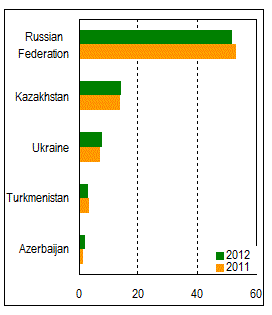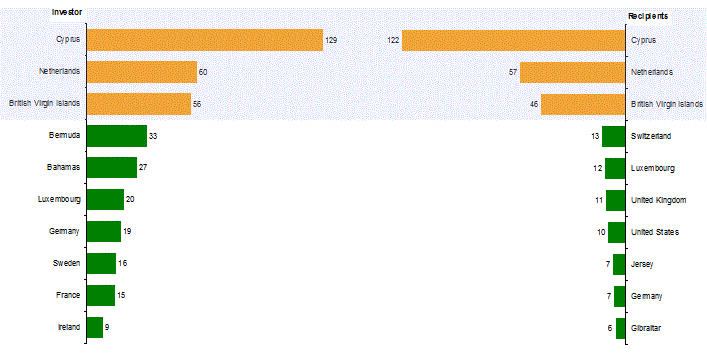Foreign direct investment (FDI) inflows to transition economies declined by 9 per cent to US$87 billion in 2012, UNCTAD’s World Investment Report 20131 reveals. It says flows to South-East Europe almost halved, while those to Commonwealth of Independent States (CIS) countries remained relatively resilient.
The report, which is subtitled Global Value Chains: Investment and Trade for Development, was released today.
In South-East Europe, a drop in FDI from $7.2 billion to $4.2 billion was due primarily to a decline in investments from neighbouring countries, which are the main investors in this subregion. In the CIS, FDI flows fell by 7 per cent from $88 billion to $82 billion. This relatively small decline is due to the fact that foreign investors continued to be attracted by the region’s growing consumer markets and vast natural resources. Inflows remained concentrated in a few economies, with the top three destinations (Russian Federation, Kazakhstan and Ukraine) accounting for 84 per cent of the region’s total inflows (figure 1).
FDI inflows to the Russian Federation decreased by 7 per cent to $51 billion. Foreign investors continued to be motivated by the growing domestic market, as shown by relatively high investments in the automotive and financial industries through reinvestment. The Russian Federation’s accession to the World Trade Organization (WTO) also had an impact on investors’ decision-making for certain projects. Developed economies, mainly European Union members, remained the largest sources of inward FDI for the Russian Federation.
FDI inflows into Kazakhstan rose by 1 per cent, reaching $14 billion – the second-highest level ever recorded – owing to its vast natural resources and economic growth. In addition to extractive industries, which accounted for almost one fifth of FDI flows to Kazakhstan in 2012, financial services attracted 12 per cent of flows. Ukraine experienced a record of almost $8 billion in FDI inflows.
The sluggishness of FDI in transition economies as a whole in 2012 was caused by a slump in cross-border mergers and acquisitions (M&A) sales, whose net value (new M&As minus divested M&As) turned negative for the first time ever. Greenfield projects – that is, new investment or the expansion of existing investment in recipient nations, as opposed to investment there via mergers and acquisitions – also declined considerably.
Outward FDI flows from transition economies declined in 2012, too. The Russian Federation continued to dominate outward FDI from the region, accounting for 92 per cent of outflows in 2012. Although natural-resource-based TNCs continued their expansion abroad, the largest acquisitions took place in the financial industry. For example, Sberbank – the largest Russian Bank – acquired Turkey’s Denizbank for $3.9 billion.
In addition to the usual sources of FDI, a distinctive feature of FDI patterns in the Russian Federation is the phenomenon of “round-tripping,” implied by a very high correlation of inward and outward investment flows between the country and financial hubs such as Cyprus and the British Virgin Islands. A closer look at the FDI stock in and from the Russian Federation, for example, reveals that the three largest investors – Cyprus, the Netherlands, and the British Virgin Islands – are also the largest recipients of FDI stock, with roughly the same amounts flowing in both directions (figure 2). Together, they account for about 60 per cent of both inward and outward FDI stock.
Before the onset of the financial and economic crisis, South-East European countries made significant progress in attracting FDI. The surge in FDI to the region, especially after 2006, was driven largely by the economic recovery, a better investment climate, and the start of association (and accession) negotiations with the EU in 2005. This positive trend was reversed in 2009. Croatia – the most seriously hit country – saw FDI flows fall from $6 billion in 2008 to $432 million in 2010. During that period, FDI flows also declined significantly to Bosnia and Herzegovina, Montenegro, and the former Yugoslav Republic of Macedonia. By contrast, Albania bucked the trend, mainly because of its investor-friendly business environment and the opportunities opened up by privatization of State-owned enterprises. The fragility of FDI flows to South-East Europe related partly to the large share of inward FDI from the EU, where economic woes have had particularly negative knock-on effects for FDI in the subregion, the report says.
Figure 1. Transition economies: Top 5 recipients of FDI inflows, 2011 and 2012
(billions of US dollars)
Source: UNCTAD. World Investment Report 2013.
Figure 2. Russian Federation: Top 10 investors and recipients of FDI stock, 2011
(billions of US dollars)
Source: UNCTAD. World Investment Report 2013.



